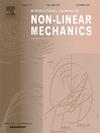动荷载作用下钢筋混凝土板的冲击响应与优化:有限元分析研究
IF 2.8
3区 工程技术
Q2 MECHANICS
International Journal of Non-Linear Mechanics
Pub Date : 2025-07-01
DOI:10.1016/j.ijnonlinmec.2025.105200
引用次数: 0
摘要
本研究利用ABAQUS/CAE中的有限元分析(FEA)研究了钢筋混凝土(RC)板在冲击载荷下的行为。建立了760 mm × 760 mm × 76 mm RC板模型,并使用Drucker-Prager塑性模型对材料的线性和非线性行为进行了校准。模拟进行了边界条件,冲击速度和加固配置。结果显示,与完全固定的板(6.8 mm)相比,一侧固定的板(12.4 mm)发生最大位移。边界条件对应力分布有显著影响,悬臂工况下最大von Mises应力为38.5 MPa,完全固定工况下最大von Mises应力为25.2 MPa。将冲击速度从4500 mm/s增加到7200 mm/s,位移从8.6 mm增加到14.1 mm,应力从22.4 MPa增加到41.7 MPa,稳定在6500 mm/s以上。用钢板代替传统的钢筋减少了22%的位移,改善了应力分布,而减少40%的钢板体积导致位移增加了15%。这些发现强调了边界条件、材料非线性和优化钢筋设计对于预测RC板在动荷载下的响应的重要性,为提高高冲击情景下的结构弹性提供了关键见解。本文章由计算机程序翻译,如有差异,请以英文原文为准。
Impact response and optimization of reinforced concrete slabs under dynamic loading: A finite element analysis study
This study investigates the behaviour of reinforced concrete (RC) slabs under impact loading using Finite Element Analysis (FEA) in ABAQUS/CAE. A 760 mm × 760 mm × 76 mm RC slab model was developed with material properties calibrated for both linear and nonlinear behaviour using the Drucker-Prager plasticity model. Simulations were conducted across boundary conditions, impact velocities, and reinforcement configurations. Results revealed that maximum displacement occurred in slabs with one side fixed (12.4 mm) compared to fully fixed slabs (6.8 mm). Boundary conditions significantly influenced stress distribution, with maximum von Mises stress recorded at 38.5 MPa for the cantilever case and 25.2 MPa for fully fixed conditions. Increasing impact velocity from 4500 mm/s to 7200 mm/s increased displacement from 8.6 mm to 14.1 mm and stress from 22.4 MPa to 41.7 MPa, stabilizing beyond 6500 mm/s. Replacing traditional reinforcement with a steel plate reduced displacement by 22 % and improved stress distribution, while reducing the steel plate volume by 40 % resulted in a 15 % increase in displacement. These findings underscore the importance of boundary conditions, material non-linearity, and optimized reinforcement design for predicting RC slab responses under dynamic loads, offering key insights for improving structural resilience in high-impact scenarios.
求助全文
通过发布文献求助,成功后即可免费获取论文全文。
去求助
来源期刊
CiteScore
5.50
自引率
9.40%
发文量
192
审稿时长
67 days
期刊介绍:
The International Journal of Non-Linear Mechanics provides a specific medium for dissemination of high-quality research results in the various areas of theoretical, applied, and experimental mechanics of solids, fluids, structures, and systems where the phenomena are inherently non-linear.
The journal brings together original results in non-linear problems in elasticity, plasticity, dynamics, vibrations, wave-propagation, rheology, fluid-structure interaction systems, stability, biomechanics, micro- and nano-structures, materials, metamaterials, and in other diverse areas.
Papers may be analytical, computational or experimental in nature. Treatments of non-linear differential equations wherein solutions and properties of solutions are emphasized but physical aspects are not adequately relevant, will not be considered for possible publication. Both deterministic and stochastic approaches are fostered. Contributions pertaining to both established and emerging fields are encouraged.

 求助内容:
求助内容: 应助结果提醒方式:
应助结果提醒方式:


